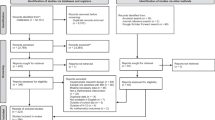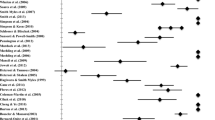Abstract
This systematic review of literature synthesizes research on video-based instruction (VBI) to teach mathematics to students with autism spectrum disorder (ASD). Eleven studies, including gray literature, were included in the synthesis resulting in data analysis of performance from 29 participants. To better align with transparent reporting guidelines of PRISMA (Moher et al., PLoS Medicine 6(7), 2009), we synthesize information regarding participants, intervention outcomes, and study design. Effects of student and study-level outcomes are presented in non-overlapping data (PND) and improvement rate difference (IRD). Findings show VBI has considerable support for positive effects across types of VBI, student characteristics, and mathematical concepts. Effective interventions incorporated academic and behavioral components with evidence base. With six studies demonstrating strong evidence, 16 individual cases of effect, and research spanning at least three research teams and research locations, results indicate that VBI meets minimum evidence set forth by Reichow et al., (Journal of Autism and Developmental Disorders 38:1311–1319, 2008) to be an established evidence-based practice to teach mathematics to students with ASD.

Similar content being viewed by others
References
*Included in the review
Alberto, P., & Troutman, A. C. (2013). Applied behavior analysis for teachers (9th ed.). Upper Saddle River: Merrill/Pearson.
American Psychiatric Association. (2013). Diagnostic and statistical manual of mental disorders: DSM-5 (5th ed.). Washington, DC: Author.
Barnett, J. E. H., & Cleary, S. (2015). Review of evidence-based mathematics interventions for students with autism spectrum disorders. Education and Training in Autism and Developmental Disabilities, 50(2), 172–185.
Browder, D. M., Trela, K., Courtade, G. R., Jimenez, B. A., Knight, V., & Flowers, C. (2012). Teaching mathematics and science standards to students with moderate and severe disabilities. Journal of Special Education, 46, 26–35. https://doi.org/10.1177/0022466910369942.
*Burton, C. E., Anderson, D. H., Prater, M. A., & Dyches, T. T. (2013). Video self-modeling on an iPad to teach functional math skills to adolescents with autism and intellectual disability. Focus on Autism and Other Developmental Disabilities, 28, 67–77. https://doi.org/10.1177/1088357613478829.
Cihak, D. F., & Bowlin, T. (2009). Using video modeling via handheld computers to improve geometry skills for high school students with learning disabilities. Journal of Special Education Technology, 24(4), 17–29. https://doi.org/10.1177/016264340902400402.
Cihak, D. F., & Grim, J. (2008). Teaching students with autism spectrum disorder and moderate intellectual disabilities to use counting-on strategies to enhance independent purchasing skills. Research in Autism Spectrum Disorders, 2, 716–727. https://doi.org/10.1016/j.rasd.2008.02.006.
Cihak, D., Alberto, P. A., Taber-Doughty, T., & Gama, R. I. (2006). A comparison of static picture prompting and video prompting simulation strategies using group instructional procedures. Focus on Autism and Other Developmental Disabilities, 21, 89–99. https://doi.org/10.1177/10883576060210020601.
Fleury, V. P., Hedges, S., Hume, K., Browder, D. M., Thompson, J. L., Fallin, K., El Zein, F., Reutebuch, C. K., & Vaughn, S. (2014). Addressing the academic needs of adolescents with autism spectrum disorder in secondary education. Remedial and Special Education, 35, 68–79. https://doi.org/10.1177/0741932513518823.
Gage, N. A., Cook, B. G., & Reichow, B. (2017). Publication bias in special education meta analyses. Exceptional Children, 83, 428–445. https://doi.org/10.1177/0014402917691016.
Geary, D. C. (2004). Mathematics and learning disabilities. Journal of Learning Disabilities, 37, 4–15.
Gevarter, C., Bryant, D. P., Bryant, B., Watkins, L., Zamora, C., & Sammarco, N. (2016). Mathematics interventions for individuals with autism spectrum disorder: a systematic review. Journal of Autism and Developmental Disorders, 3, 224–238. https://doi.org/10.1007/s40489-016-0078-9.
Hong, E. R., Ganz, J. B., Mason, R., Morin, K., Davis, J. L., Ninci, J., Neely, L. C., Boles, M. B., & Gilliland, W. D. (2016). The effects of video modeling in teaching functional living skills to persons with ASD: a meta-analysis of single-case studies. Research in Developmental Disabilities, 57, 158–169. https://doi.org/10.1016/j.ridd.2016.07.001.
Hughes, E. M. (2019). Point of view video modeling to teach simplifying fractions to middle school students with mathematical learning disabilities. Learning Disabilities: A Contemporary Journal, (in press).
Hughes, E. M., & Yakubova, G. (2016). Developing hand-held video intervention for students with autism spectrum disorder. Intervention in School and Clinic, 52, 115–121. https://doi.org/10.1177/1053451216636059.
Jones, C. R., Happé, F., Golden, H., Marsden, A. J., Tregay, J., Simonoff, E., Pickles, A., Baird, G., & Charman, T. (2009). Reading and arithmetic in adolescents with autism spectrum disorders: peaks and dips in attainment. Neuropsychology, 23(6), 718–728. https://doi.org/10.1037/a0016360.
*Jowett, E. L., Moore, D. W., & Anderson, A. (2012). Using an iPad-based video modeling package to teach numeracy skills to a child with an autism spectrum disorder. Developmental Neurorehabilitation, 15, 304–312. https://doi.org/10.3109/17518423.2012.682168.
*Kaffer, C. L. (2014). The effects of video modeling on skill acquisition in children with autism spectrum disorder. Unpublished dissertation through the University of Arizona.
Kazdin, A. E. (2011). Single-case research designs: Methods for clinical and applied settings (2nd ed.). New York: Oxford University Press.
Keen, D., Webster, A., & Ridley, G. (2016). How well are children with autism spectrum disorder doing academically at school? An overview of the literature. Autism, 20(3), 276–294. https://doi.org/10.1177/1362361315580962.
*Kellems, R. O., Frandsen, K., Hansen, B., Gabrilsen, T., Clarke, B., Simons, K., & Clements, K. (2016). Teaching multi-step math skills to adults with disabilities via video prompting. Research in Developmental Disabilities, 58, 31–44. https://doi.org/10.1016/j.ridd.2016.08.013.
King, S. A., Lemons, C. J., & Davidson, K. A. (2016). Math interventions for students with autism spectrum disorder. Exceptional Children, 82, 443–462. https://doi.org/10.1177/0014402915625066.
*Knight, V. F., Kuntz, E. M., & Brown, M. (2018). Paraprofessional-delivered video prompting to teach academics to students with severe disabilities in inclusive settings. Journal of Autism and Developmental Disorders, 48, 6, 2203–2216. https://doi.org/10.1007/s10803-018-3476-2.
Kratochwill, T., Hitchcock, J., Horner, R., Levin, J., Odom, S., Rindskopf, D., & Shadish, W. (2013). Single-case intervention research design standards. Remedial & Special Education, 34, 26–38. https://doi.org/10.1177/0741932512452794.
Mason, R. A., Ganz, J. B., Parker, R. I., Burke, M. D., & Camargo, S. P. (2012). Moderating factors of video-modeling with other as model: a meta-analysis of single-case studies. Research in Developmental Disabilities, 33(4), 1076–1086. https://doi.org/10.1016/j.ridd.2012.01.016.
Mason, R. A., Davis, H. S., Boles, M. B., & Goodwyn, F. (2013). Efficacy of point-of-view modeling: a meta-analysis. Remedial and Special Education, 34(6), 333–345. https://doi.org/10.1177/0741932513486298.
Mayes, S. D., & Calhoun, S. L. (2006). Frequency of reading, math, and writing disabilities in children with clinical disorders. Learning and Individual Differences, 16, 145–157. https://doi.org/10.1016/j.lindif.2005.07.004.
Moher, D., Liberati, A., Tetzlaff, J., Altman, D. G., & The PRISMA Group. (2009). Preferred reporting items for systematic reviews and meta-analyses: the PRISMA statement. PLoS Medicine, 6(7), e1000097. https://doi.org/10.1371/journal.pmed1000097.
Parker, R. I., Vannest, K. J., & Brown, L. (2009). The improvement rate difference for single-case research. Exceptional Children, 75, 135–150. https://doi.org/10.1177/001440290907500201.
Parker, R. I., Vannest, K. J., & Davis, J. L. (2011). Effect size in single-case research: a review of nine nonoverlap techniques. Behavior Modification, 35, 303–322. https://doi.org/10.1177/0145445511399147.
Reichow, B., & Volkmar, F. R. (2010). Best-evidence synthesis of social skills interventions for individuals with autism spectrum disorders. Journal of Autism and Developmental Disorders, 40, 149–166. https://doi.org/10.1007/s10803-009-0842-0.
Reichow, B., Volkmar, F. R., & Cicchetti, D. V. (2008). Development of the evaluative method for evaluating and determining evidence-based practices in autism. Journal of Autism and Developmental Disorders, 38, 1311–1319. https://doi.org/10.1007/s10803-007-0517-7.
*Saunders, A. F. (2014). Effects of schema-based instruction delivered through computer-based video instruction on mathematical word problem solving of students with autism spectrum disorder and moderate intellectual disability. Unpublished Doctoral Dissertation, The University of North Carolina at Charlotte.
Schaefer-Whitby, P. J. S., Travers, J. C., & Harnik, J. (2009). Academic achievement and strategy instruction to support the learning of children with high-functioning autism. Beyond Behavior, 19, 3–9.
Scruggs, T. E., & Mastropieri, M. A. (1998). Synthesizing single subject studies: Issues and applications. Behavior Modification, 22, 221–242.
Vannest, K. J., Parker, R. I., Gonen, O., & Adiguzel, T. (2016). Single case research: Web-based calculators for SCR analysis. (Version 2.0) [Web-based application]. College Station: Texas A&M University Retrieved from www.singlecaseresearch.org. Accessed 25 Jan 2019.
Wei, X., Lenz, K. B., & Blackorby, J. (2012). Math growth trajectories of students with disabilities: disability category, gender, racial, and socioeconomic status differences from ages 7 to 17. Remedial and Special Education, 34, 154–165. https://doi.org/10.1177/0741932512448253.
Wei, X., Christiano, E. R., Yu, J. W., Wagner, M., & Spiker, D. (2015). Reading and math achievement profiles and longitudinal growth trajectories of children with an autism spectrum disorder. Autism, 19, 200–210. https://doi.org/10.1177/1362361313516549.
Weng, P., & Bouck, E. C. (2014). Using video prompting via iPads to teach price comparison to adolescents with autism. Research in Autism Spectrum Disorders, 8, 1404–1415. https://doi.org/10.1016/j.rasd.2014.06.014.
Williams, D. L., Goldstein, G., Kojkowski, N., & Minshew, N. J. (2008). Do individuals with high-functioning autism have the IQ profile associated with nonverbal learning disability? Research in Autism Spectrum Disorders, 2, 353–361. https://doi.org/10.1016/j.rasd.2007.08.005.
Wong, C., Odom, S. L., Hume, K., Cox, A. W., Fettig, A., Kucharczyk, K., Brock, M. E., Plavnick, J. B., Fleury, V. P., & Schultz, T. A. (2014). Evidence-based practices for children, youth, and young adults with autism spectrum disorder. Chapel Hill: Frank Porter Graham Child Development Institute.
*Yakubova, G., Hughes, E. M., & Hornberger, E. (2015). Video-based intervention in teaching fraction problem-solving to students with autism spectrum disorder. Journal of Autism and Developmental Disorders, 45, 2865–2875. https://doi.org/10.1007/s10803-015-2449-1.
*Yakubova, G., Hughes, E. M., & Shinaberry, M. (2016). Learning with technology: Video modeling with concrete, representational, abstract sequence for students with autism spectrum disorders. Journal of Autism and Developmental Disorder, 46, 2349–2362. https://doi.org/10.1007/s10803-016-2768-7.
Acknowledgments
This manuscript was not financially supported by any grants. An earlier version of this paper was presented at the American Educational Research Association Annual Meeting.
Author information
Authors and Affiliations
Corresponding author
Ethics declarations
Ethical Approval
This article does not contain any studies with human participants or animals performed by any of the authors. For the Authors’ publication(s) within the synthesis: All procedures performed in studies involving human participants were in accordance with the ethical standards of the institutional and/or national research committee and with the 1964 Helsinki declaration and its later amendments or comparable ethical standards. Informed consent was obtained from all individual participants included in the study.
Additional information
Publisher’s Note
Springer Nature remains neutral with regard to jurisdictional claims in published maps and institutional affiliations.
At the time of the study, Dr. Elizabeth Hughes was an Assistant Professor of Special Education at The Pennsylvania State University, University Park, PA, USA. Dr. Gulnoza Yakubova was an Assistant Professor of Special Education at University of Maryland, College Park, MD, USA. No institution or other changes occurred during the study.
Rights and permissions
About this article
Cite this article
Hughes, E.M., Yakubova, G. Addressing the Mathematics Gap for Students with ASD: an Evidence-Based Systematic Review of Video-Based Mathematics Interventions. Rev J Autism Dev Disord 6, 147–158 (2019). https://doi.org/10.1007/s40489-019-00160-3
Received:
Accepted:
Published:
Issue Date:
DOI: https://doi.org/10.1007/s40489-019-00160-3




